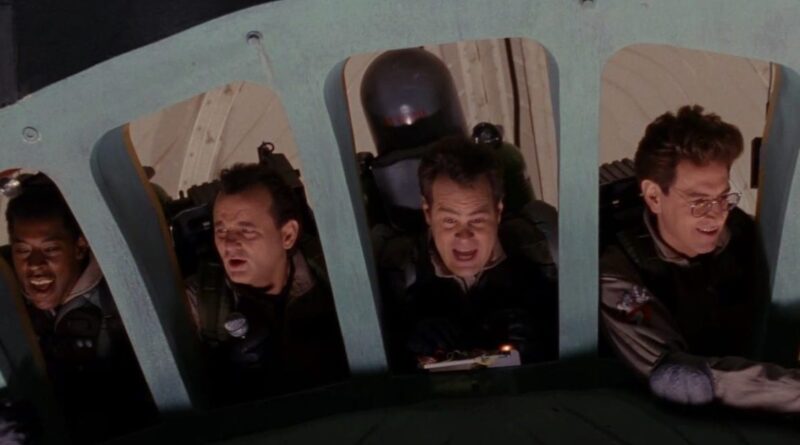Ghostbusters II (1989)
The success of 1984’s Ghostbusters pretty much guaranteed a Saturday morning cartoon spinoff, which in turn guaranteed toy stores filled with tie-in action figures and play sets. I’m quite familiar with said merchandise, so I know it’s often paired with plastic tubs filled with purple-colored goo. This is, of course, meant to represent ectoplasm, only touched on in the film but allowed to take off in the cartoon. This brings me to Ghostbusters II, which, like its predecessor, was produced and directed by Ivan Reitman; the popularity of both the cartoon and the toys has seen to it that ectoplasm is at the heart of the film’s plot. A lot of that stuff is shown, sometimes in very large quantities, most notably as it flows like a river through an abandoned New York City subway station.
There’s so much of it, we eventually learn, because the negative emotions of New Yorkers have manifested it. But never fear; the title characters determine that it’s possible for the ectoplasm – or slime, as they call it – to also be infused with positive energy. This comes in very handy during the film’s climax, which involves the Statue of Liberty and a lot of really good special effects. While we’re talking about positivity, remember the ghost in the previous film that slimed Bill Murray? The small green monster with a huge appetite? The cartoon series saw that character turned into a friendly Ghostbusters sidekick, appropriately named Slimer; Ghostbusters II not only includes Slimer, he’s made into more of a comic figure that’s mischievous rather than malevolent. He even gets his own on-screen credit, as if he was one of the film’s human actors.
The plot involves the discovery of the aforementioned slime river and its connection to the evil spirit of sixteenth-century madman Vigo the Carpathian (Wilhelm von Homburg), currently possessing his own painted portrait at a Manhattan art museum. This comes after a five-year period of paranormal inactivity in New York City, which, along with legal woes, drove the Ghostbusters out of business. Peter Venkman (Bill Murray) is now the host of a third-rate psychic talk show. Ray Stantz (Dan Aykroyd) owns an occult bookstore, and on the side does poorly received Ghostbusters-themed birthday parties with Winston Zeddemore (Ernie Hudson). Egon Spengler (Harold Ramis) is still the brainy scientist, introduced at a research institute conducting experiments involving human emotions.
They’re all reunited and put back in business as paranormal activity picks up again. This brings me to Dana Barrett (Sigourney Weaver), who, since the events of the first film, broke up with Peter, married someone else, got divorced, became an art restorer, and is now a single mother to a toddler named Oscar (Will and Hank Deutschendorff); her son has been chosen by Vigo as the vessel for his spirit, and if all goes according to plan, Vigo will live once again on the stroke of midnight on New Year’s Day. Acting as Vigo’s minion is Janosz (Peter MacNicol), the goofy stereotype of the foreigner with the unplaceable European accent. He’s the head of the restoration department Dana works in – and of course he lusts after her, even though the feeling is anything but mutual.
That’s all of the plot you need to know. Now let’s talk about a few other characters, most of them familiar. Louis Tully (Rick Moranis) remains a nerdy, socially awkward accountant, although he’s forced into being the Ghostbusters’ attorney when they’re put on trial for causing a citywide blackout. Janine Melnitz (Annie Potts) returns as the Ghostbusters’ secretary, although her personality has changed, and not for the better; rather than a hardened New Yorker with a soft spot for Egon, she’s now an eccentrically dressed ditz whose affections have shifted to Louis. The Mayor of New York (David Margulies) returns, and is now joined by an assistant (Kurt Fuller) who, like William Atherton in the previous film, hates the Ghostbusters and takes drastic measures to get them out of the way.
One of the issues I had with the first film was that pop music took precedence over Elmer Bernstein’s score, in effect keeping the film dated to 1984. Ghostbusters II has the same problem, with the added insult that the new score by Randy Edelman, while competent, doesn’t hit the mark like Bernstein’s did. Of course Ray Parker Jr.’s now iconic title song is included, but the new main theme is a pop/rap song by Bobby Brown. Indeed, the film will forever remain in 1989 with a more hip hop-influenced soundtrack, although there are contributions by Glenn Frey, Oingo Boingo, and Elton John. But don’t get me wrong; none of that changes the fact that Ghostbusters II is a fun movie. It may not be as much fun as the original, and the toyetic influence of the cartoon series is too prominent to overlook, but it’s fun just the same.




